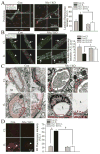Selective knockout of astrocytic Na+ /H+ exchanger isoform 1 reduces astrogliosis, BBB damage, infarction, and improves neurological function after ischemic stroke
- PMID: 28925083
- PMCID: PMC5705024
- DOI: 10.1002/glia.23232
Selective knockout of astrocytic Na+ /H+ exchanger isoform 1 reduces astrogliosis, BBB damage, infarction, and improves neurological function after ischemic stroke
Abstract
Stimulation of Na+ /H+ exchanger isoform 1 (NHE1) in astrocytes causes ionic dysregulation under ischemic conditions. In this study, we created a Nhe1flox/flox (Nhe1f/f ) mouse line with exon 5 of Nhe1 flanked with two loxP sites and selective ablation of Nhe1 in astrocytes was achieved by crossing Nhe1f/f mice with Gfap-CreERT2 Cre-recombinase mice. Gfap-CreERT2+/- ;Nhe1f/f mice at postnatal day 60-90 were treated with either corn oil or tamoxifen (Tam, 75 mg/kg/day, i.p.) for 5 days. After 30 days post-injection, mice underwent transient middle cerebral artery occlusion (tMCAO) to induce ischemic stroke. Compared with the oil-vehicle group (control), Tam-treated Gfap-CreERT2+/- ;Nhe1f/f (Nhe1 KO) mice developed significantly smaller ischemic infarction, less edema, and less neurological function deficits at 1-5 days after tMCAO. Immunocytochemical analysis revealed less astrocytic proliferation, less cellular hypertrophy, and less peri-lesion gliosis in Nhe1 KO mouse brains. Selective deletion of Nhe1 in astrocytes also reduced cerebral microvessel damage and blood-brain barrier (BBB) injury in ischemic brains. The BBB microvessels of the control brains show swollen endothelial cells, opened tight junctions, increased expression of proinflammatory protease MMP-9, and significant loss of tight junction protein occludin. In contrast, the Nhe1 KO mice exhibited reduced BBB breakdown and normal tight junction structure, with increased expression of occludin and reduced MMP-9. Most importantly, deletion of astrocytic Nhe1 gene significantly increased regional cerebral blood flow in the ischemic hemisphere at 24 hr post-MCAO. Taken together, our study provides the first line of evidence for a causative role of astrocytic NHE1 protein in reactive astrogliosis and ischemic neurovascular damage.
Keywords: MMP; astrocyte end-feet; blood-brain barrier; cerebral edema; gliosis; neurovascular unit.
© 2017 Wiley Periodicals, Inc.
Figures







References
-
- Amantea D, Certo M, Russo R, Bagetta G, Corasaniti MT, Tassorelli C. Early reperfusion injury is associated to MMP2 and IL-1beta elevation in cortical neurons of rats subjected to middle cerebral artery occlusion. Neuroscience. 2014;277:755–763. - PubMed
-
- Amiry-Moghaddam M, Otsuka T, Hurn PD, Traystman RJ, Haug FM, Froehner SC, Adams ME, Neely JD, Agre P, Ottersen OP, Bhardwaj A. An alpha-syntrophin-dependent pool of AQP4 in astroglial end-feet confers bidirectional water flow between blood and brain. Proc Natl Acad Sci U S A. 2003;100:2106–2111. - PMC - PubMed
Publication types
MeSH terms
Substances
Grants and funding
LinkOut - more resources
Full Text Sources
Other Literature Sources
Molecular Biology Databases
Research Materials
Miscellaneous

